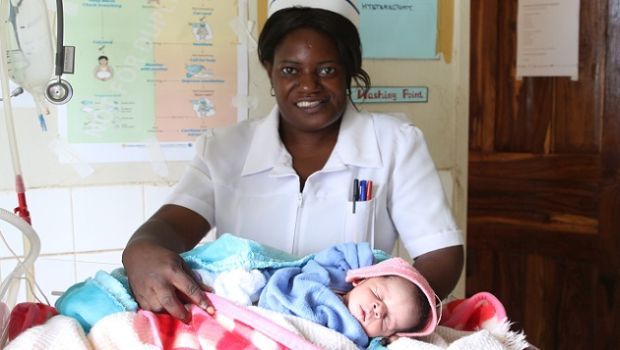Simple Solution Improves Water and Sanitation in Zambian Healthcare Facilities
When Mary Mwape, a midwife, delivers babies at Lubwe Mission Hospital in Luapula Province of Zambia, there’s often no water to wash her hands or clean the newborn. Yet mothers from all over the region are referred to the hospital for delivery and related healthcare activities.


Mary Mwape, a midwife at Lubwe Mission Hospital in Luapula Province of Zambia. Photo courtesy of WaterAid/C. Chanda
When Mary Mwape, a midwife, delivers babies at Lubwe Mission Hospital in Luapula Province of Zambia, there’s often no water to wash her hands or clean the newborn. Yet mothers from all over the region are referred to the hospital for delivery and related healthcare activities.
“We know that we are supposed to wash our hands thoroughly before attending to another patient but what do you do in a situation where there is no running water?” she asks.
Mwape’s challenge is not unique. Water, toilets and soap are absent in numerous hospitals and health centers in many low-income countries. Without basic water, sanitation and hygiene (WASH) services, it is difficult for healthcare workers to prevent and control infectious diseases.
“If a newborn child with a fresh umbilical cord is washed using water from shallow, open wells or unsafe water, the child is likely to be infected with diseases like neonatal tetanus or neonatal sepsis which may lead to death,” Mwape explains. “A labor ward without water is a danger to the life of newborn children,” she adds.
Zambia has made efforts to improve WASH services in healthcare facilities. In 2010, the Ministry of Health with support from Tropical Disease Research Center and other organizations, installed small water stations for safe drinking and handwashing in 150 healthcare facilities, mostly in rural communities. The facilities were chosen because they reported high levels of diarrhea and low access to clean water.
The project placed two locally produced water stations at key points in each healthcare facility. One 60-liter water station provides chlorinated water that is safe for drinking. The second 70-liter water station is used for handwashing with soap.
Although providing water is a challenge across Zambia, the project requires all healthcare facilities to have a water supply inside or nearby to keep the tanks full. Depending on the health facility’s water supply, the water stations are filled either by well, piped or delivered water. There are dedicated personnel to manage the stations in order to ensure proper operation and disinfection of water supplies.
“The water stations ensure patients can take their medications with safe water and the healthcare workers can wash their hands between patients,” explains Mathias Tembo, a senior medical scientist at Tropical Disease Research Center. “If we don’t provide treated water, various diseases will continue to be transmitted in the healthcare facilities.”
Besides making it possible for healthcare workers to wash their hands, the water stations are increasing patients’ satisfaction and promoting hygiene practices. Healthcare workers are capitalizing on a “teachable moment” by encouraging patients to wash their hands and treat their drinking water at home.
And, recent home visits have shown the program is working. Patients are now regularly washing their hands with soap and safely storing and treating their water.
“Efforts need to continue to ensure we improve the provision of water, but also that we have safe and reliable supplies of drinking water in all health care facilities in Zambia,” says Tembo. “While we have not focused on this area in the past, it is important we start.”
Use of alcohol-based handrubs is an important complementary measure that also allows for hand hygiene to prevent infection, but these are not widely available.
According to WHO and UNICEF’s report, “Water, sanitation and hygiene in healthcare facilities: status in low- and middle-income countries and way forward," more than 1 in 3 healthcare facilities in low-resource settings do not have any access to water at all. When the reliability, safety and distance of the water supply is taken into account, that ratio increases to 1 in 2. But, lack of water is only one challenge; nearly 1 in 5 of these facilities does not also have toilets and more than 1 in 3 does not have soap for handwashing.
Without safe water, toilets and soap, healthcare workers like Mary Mwapecannot carry out proper infection prevention and control measures and demonstrate safe practices to their patients. They also put babies at risk of developing life-threatening diseases.
Simple measures, like Zambia’s water stations, can make an immediate difference. WHO, UNICEF and partners, like WaterAid, are working to increase water, sanitation, and hygiene services in healthcare facilities in low- and middle-income countries, so that more patients can receive care in safe environments.
Realizing long-term sustainable improvements will require a global action plan that integrates stronger policies, greater financial commitments and ample human resources. The World Health Organization (WHO) and UNICEF are working to development and implement the first plan.
Source: WHO
Show, Tell, Teach: Elevating EVS Training Through Cognitive Science and Performance Coaching
April 25th 2025Training EVS workers for hygiene excellence demands more than manuals—it requires active engagement, motor skills coaching, and teach-back techniques to reduce HAIs and improve patient outcomes.
The Rise of Disposable Products in Health Care Cleaning and Linens
April 25th 2025Health care-associated infections are driving a shift toward disposable microfiber cloths, mop pads, and curtains—offering infection prevention, regulatory compliance, and operational efficiency in one-time-use solutions.
Phage Therapy’s Future: Tackling Antimicrobial Resistance With Precision Viruses
April 24th 2025Bacteriophage therapy presents a promising alternative to antibiotics, especially as antimicrobial resistance continues to increase. Dr. Ran Nir-Paz discusses its potential, challenges, and future applications in this technology.